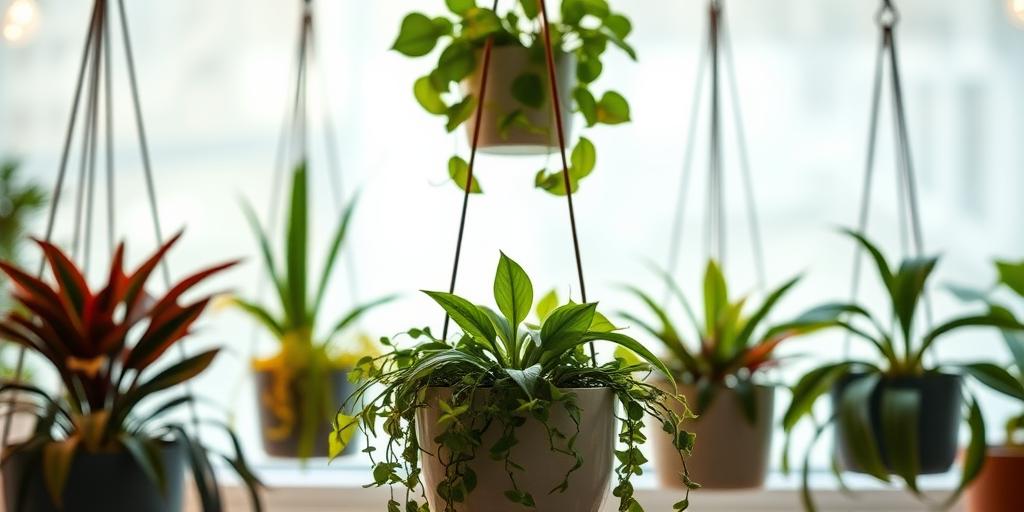
How to Care for Low Light Hanging Plants: A Complete Guide
Discover the best ways to care for low light hanging plants with this complete guide! Learn about ideal species, watering tips, and maintenance tricks to keep your indoor greenery thriving.
Introduction
Did you know that some of the most resilient houseplants thrive in low light? Whether you live in a dim apartment or just want to add greenery to a shady corner, low light hanging plants are the perfect solution! From the lush Pothos to the elegant Spider Plant, these beauties can brighten up any space with minimal effort. In this guide, we’ll walk you through everything you need to know—from choosing the right plants to keeping them healthy and vibrant. Let’s dive in!
Best Low Light Hanging Plants for Your Home
If you’re looking to add greenery to dimly lit corners of your home, certain hanging plants thrive in low light conditions. Here are some top picks:
Devil’s Ivy (Pothos) – This hardy plant is perfect for beginners. Its heart-shaped leaves grow quickly, trailing up to 10 feet long. It adapts well to low light and can even survive fluorescent lighting.
Philodendron (Heartleaf Philodendron) – Similar to Devil’s Ivy, this plant has glossy, deep green leaves and a vining habit. It grows moderately fast and can trail several feet, making it ideal for high shelves or hanging baskets.
Spider Plant – Known for its arching, striped leaves, the Spider Plant is resilient and produces “pups” (baby plants) that dangle from long stems. It tolerates low light but grows best with some indirect sunlight.
Where to Place Them for Optimal Growth
Since these plants thrive in low light, they do well in:
-
Bathrooms (humidity-loving varieties like Philodendron)
-
Hallways or entryways with minimal natural light
-
North-facing windows where sunlight is indirect and gentle
Ideal Lighting Conditions for Low Light Hanging Plants
What Qualifies as “Low Light”?
Low light doesn’t mean no light. It refers to:
-
Indirect sunlight (bright but not direct, like near a shaded window)
-
Filtered light (through sheer curtains)
-
Artificial light (fluorescent or LED grow lights)
Signs Your Plant Isn’t Getting Enough Light
-
Yellowing leaves (especially new growth)
-
Leggy stems (elongated gaps between leaves)
-
Slow or stunted growth
If natural light is scarce, supplement with grow lights placed 6-12 inches above the plants for 6-8 hours daily.
Watering Tips for Healthy Hanging Plants
How Often to Water
Watering frequency depends on the plant:
-
Devil’s Ivy & Philodendron: Water when the top 1-2 inches of soil are dry (usually every 1-2 weeks).
-
Spider Plant: Keep soil slightly moist but not soggy (water every 1-2 weeks).
Signs of Overwatering vs. Underwatering
-
Overwatering: Yellow leaves, mushy stems, moldy soil.
-
Underwatering: Crispy brown edges, drooping leaves.
Best Watering Techniques
-
Bottom watering: Place the pot in a tray of water and let the soil soak it up.
-
Misting: Helps increase humidity for tropical plants like Philodendrons.
Choosing the Right Soil and Fertilizer
Best Soil Mixes
Low light hanging plants need well-draining soil to prevent root rot. A good mix includes:
-
Peat moss or coco coir (retains moisture)
-
Perlite or sand (improves drainage)
-
Orchid bark (for aeration, great for epiphytes like Philodendrons)
When and How to Fertilize
-
Fertilize sparingly (every 4-6 weeks in spring/summer).
-
Dilute liquid fertilizer to half strength to avoid burning roots.
Organic vs. Synthetic Fertilizers
-
Organic (worm castings, fish emulsion): Slow-release, gentle on plants.
-
Synthetic (liquid houseplant fertilizer): Fast-acting but requires careful dosing.
Pruning and Maintenance for Longevity
Trimming Trailing Vines for Fuller Growth
-
Pinch back tips to encourage bushier growth.
-
Trim leggy stems to maintain shape and redirect energy to new leaves.
Cleaning Leaves
Dust blocks light absorption. Wipe leaves with a damp cloth or give them a gentle shower every few weeks.
Repotting Root-Bound Plants
If roots are circling the pot or growing out of drainage holes:
-
Move to a pot 1-2 inches larger.
-
Refresh soil to replenish nutrients.
Common Pests and How to Prevent Them
Identifying Common Pests
-
Spider mites: Tiny webs on leaves.
-
Mealybugs: White, cotton-like clusters.
-
Aphids: Small green or black bugs on new growth.
Natural Pest Control
-
Neem oil spray (diluted with water and soap).
-
Insecticidal soap (spray directly on pests).
Preventative Measures
-
Inspect new plants before bringing them indoors.
-
Isolate infested plants to prevent spreading.
Creative Ways to Display Hanging Plants
Best Hangers and Macramé Holders
-
Macramé plant hangers: Stylish and adjustable for different pot sizes.
-
Ceiling hooks: Secure and ideal for long trailing plants.
DIY Hanging Plant Ideas
-
Upcycled containers (mugs, baskets with liners).
-
Tension rods in windows for small-space solutions.
Grouping Plants for a Lush Effect
-
Mix textures (pair Spider Plants with Pothos for contrast).
-
Vary heights using shelves and hooks for a cascading jungle look.
By following these tips, your low light hanging plants will not only survive but thrive, adding life and beauty to even the darkest corners of your home.
Conclusion
Caring for low light hanging plants doesn’t have to be complicated! With the right species, proper watering, and a little attention, you can enjoy lush, trailing greenery even in the darkest corners of your home. Ready to transform your space? Start with a hardy Pothos or a forgiving Spider Plant, and watch your indoor jungle thrive!
